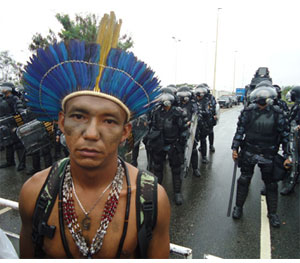Before Japan’s nuclear meltdown, it looked like the world could be ready for a nuclear renaissance, but it seems we are entering a big hydro renaissance instead.
China’s Three Gorges Dam – currently the world’s largest at 22.5 gigawatts (GW) – looks like small potatoes compared to those planned for Africa’s Congo and Brazil’s Amazon.
And China just OK’d construction of another enormous 20 GW hydroelectric project with a much taller, even more destructive dam than Three Gorges, the Sichuan project .
Brazil’s Amazon
Brazil is spending $93 billion on 20 hydropower plants and 34 dams that threaten 2500 square miles of Amazon rainforest. One of those dams, the 11 GW Belo Monte dam, would be the third largest in the world and is 20% completed.
Physically blocked for almost a year by indigenous people, they are desperately trying to preserve their home and the pristine Amazon rainforest it would destroy. It would flood 200 square miles, causing massive deforestation, greenhouse gas emissions and irreparable damage to the ecosystem, displacing over 20,000 people from 40 ethnic groups. The Xingu River is their lifeline.
They say:
"We’re not leaving until you get out of our villages. You have made the fish disappear and you are robbing the bones of our ancestors who are buried on our lands…
You are the ones killing us, quickly or slowly. We’re dying and with each dam that is built, more of us will die. When we try to talk with you, you bring tanks, helicopters, soldiers, machine guns and stun weapons.

And if the government gets away with building Belo Monte, many are terrified that it will lead to destruction of all the Amazon’s magnificent rivers, which provide a fifth of the world’s fresh water. "The Amazon would become an endless series of lifeless reservoirs, its life drained away by giant walls of concrete and steel," says International Rivers.
As for Belo Monte, explosions to build the dam, diverting the river and the associated sedimentation and pollution have already rendered the Xingu not fit to drink. Fish populations are devastated and there is little left to eat.
Here are more details about this gruesome situation.
In Chile, presidential candidates are being asked to formally pledge to keep Patagonia free of dams and invest in renewable energy instead. A major hydro project, HidroAysén, would build five dams in yet another pristine region of Patagonia. It has been stalled for a year because of widespread protests.
Africa’s Congo
Now we hear that Africa’s Democratic Republic of Congo is working on a much bigger hydro project which would be the largest in the world. Construction of the first phase – the Inga dam on the Congo river – is set to begin in 2015.
This first phase is big enough at 4.8 gigawatts (GW), but eventually, the Grand Inga project would scale to 40 GW – at a cost of $80 billion – with the capacity to provide electricity to half the African continent! That’s almost twice the size of China’s Three Gorges Dam – currently the world’s largest at 22.5 GW.
How much could $80 billion buy in solar and wind energy?
The Congo River is the world’s largest by volume after the Amazon River. The $12 billion initial phase has been held back from lack of financing, but recent support from the World Bank and African Development Bank is making it more likely and South Africa has signed on to buy 2.5 GW of power from the project – almost half its production.
Over the past 40 years, huge hydro projects have been promoted as the solution for bringing electricity to the world’s poorest country, the Democratic Republic of Congo. Because of rampant corruption and mismanagement, dams have been boondoggles – they run at about a quarter of a capacity and rather than delivering electricity to the majority of the population, 85% goes to the mining industry, says Peter Bosshard, policy director of International Rivers. Further, these centralized investments have resulted in more tension and civil war, he says.
Grid-based electrification is not a realistic option for most of Africa’s poor – as usual, these huge projects would be much better substituted by distributed renewable energy and micro hydropower.
And there are plans for a 6 GW dam in Ethiopia, which announced this week that it began diverting the Blue Nile to begin building the Grand Ethiopian Renaissance Dam. Egypt, which is downstream and has virtually no other water source is furious about the secretive project and immediately called for it to stop. The dispute could trigger a war.
Working Against Our Best Interests
Important new research shows that big hydropower plants rely on in-tact rainforests to operate because they generate the rain that keeps reservoirs full.
If deforestation continues to build the Belo Monte dam, it will only provide a third of the electricity, concludes a study published in Proceedings of the National Academy of Sciences.
"Our study shows that the huge strides Brazil has made in slowing Amazon deforestation are actually helping secure the nation’s energy supply," says Claudia Stickler, lead author and scientist at the Amazon Environmental Research Institute International Program.
"We are investing billions of dollars in hydropower plants around the world. The more rainforests left standing, the more water we’ll have in the rivers, and the more electricity we’ll be able to get from these projects," says Marcos Costa, another author of the study and climatologist at Federal University of Viçosa in Brazil.
Based on simulations of various levels of deforestation they found that rainfall has already fallen 6-7% because of Melo Bonte’s construction. Rainfall is expected to drop 11-15% if estimates of 40% deforestation by 2050 are correct, resulting in 35-40% less power.
